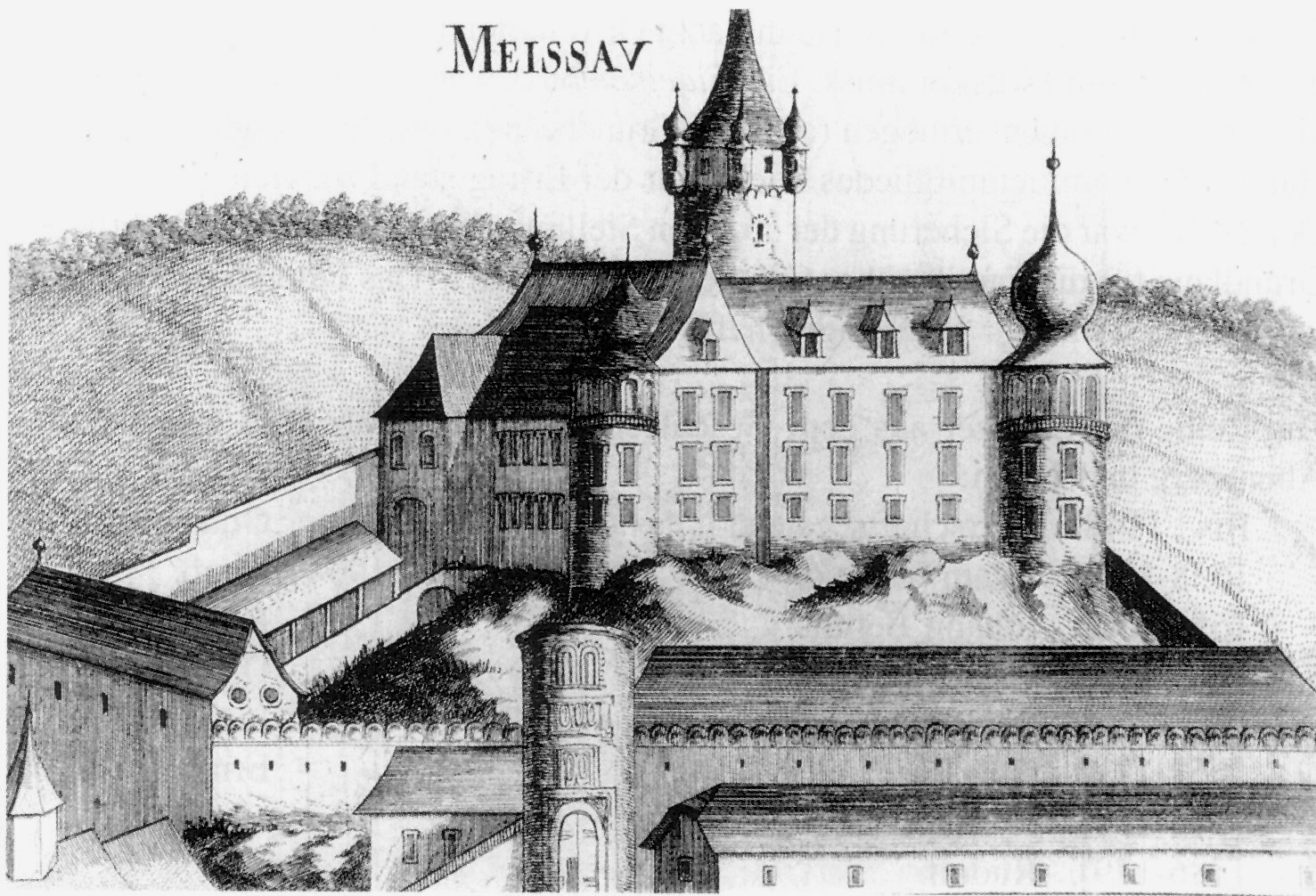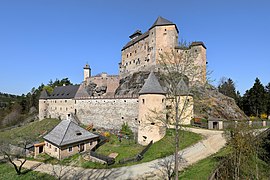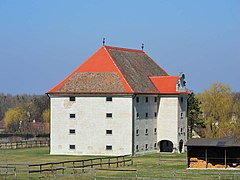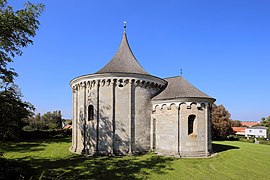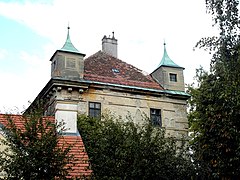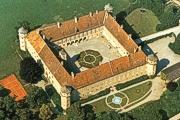Abensperg and Traun
The Abensperg and Traun family are originally from Traungau in Upper Austria and belong to the ancient nobility with the original name Traun, whose ancestral seat, Traun Castle , has been family-owned since 1120 until today.
1653 it was by Emperor Ferdinand III. Raised or "reinstated" under the name of Abensperg and Traun in the imperial count status, referring to a Bavarian family that died out around 1480, the Counts of Abensberg . From 1662 to 1804 the Abensperg and Traun ruled over the imperial direct rule of Eglof in the Allgäu and thus belonged to the high nobility of the Holy Roman Empire .
The family is one of the so-called " Apostle families", those around sixteen families who already played a role in Austria at the time of the Babenbergs (976 to 1246) and of which only four still exist in Austria today (besides the Abensperg and Traun, the Liechtenstein , Starhemberg and the Fürstenberg-Weitra ).
history
origin
The secured lineage of the family of the later Counts von Abensperg and Traun, who came from the Traungau, begins with Bernhard von Traun (Pernhart de Trune) , who is mentioned in a document in 1114 and 1120. Like various other members of the family whose names could already be identified around the middle of the 12th century, he was probably of noble origin. In the second half of the 12th century, the Lords of Traun joined the ministeriality (knightly service team) of the Otakare, also known as the Traungau counts , and after their extinction in 1192 they were accepted into the ministry of the Babenbergs . After the Babenbergs died out, the Lords of Traun finally switched to the service team of the Bishops of Passau, who were also wealthy in Upper Austria .
Two lines
The elevated position of the Lords of Traun manifested itself in the later Middle Ages through extensive property holdings, a knightly allegiance that has been proven since 1260, bailiwick rights over the properties of the monasteries of St. Florian and Göttweig as well as the exercise of various high sovereign offices, including the office of governor ob der Enns (1362) and the Hereditary Marshal's Office of Salzburg (1436).
Towards the end of the 15th century, the family belonging to the Upper Austrian gentry split into two main lines on the occasion of a property separation. The Eschelberg Line, which became extinct at the beginning of the 19th century, was given the Eschelberg Castle near St. Gotthard , which was owned by the family from 1283 to 1599 , while the Traun family castle that gave it its name remained in the possession of the Maissau Line, which has been known since the 16th century. After the reign of Maissau and Maissau Castle had inherited the Lords of Traun in 1537, the interests of the family shifted more and more to Lower Austria in the course of the early modern period.
In the second half of the 17th century, the castles and palaces Petronell (1656), Groß-Schweinbarth (1658), Rappottenstein (1664), Bockfließ and Bisamberg, some of which are still family-owned , and the early Baroque expansion (1660) in 1857 were acquired demolished Palais Traun in Vienna's Herrengasse . In 1668, Ernst Reichsgraf von Abensperg and Traun donated a Majorats Fideikommiss covering the imperial county of Eglofs, the Herrschaft Traun and several houses in Vienna and Linz and another Primogenitur-Fideikommiss concerning the Petronell dominion .
Like most of the leading families of the Austrian hereditary lands , the Lords of Traun converted to Protestantism in the confessional age and thus belonged to the class opposition to the Habsburg rulers . After the return to the Catholic faith, various members of the Traun family had the opportunity to pursue excellent court and military careers in the service of the Habsburgs from around 1620. In the 18th and 19th centuries, too, various members of the sex held a variety of military and court posts, of which the dignities of the chief hunter, chief ceremonial master and chief court master deserve special mention.
In the second half of the 19th century, the Maissauer line was divided into a Maissauer and a Petroneller branch. While Maissau , Rappottenstein , Bockfließ and Groß-Schweinbarth went to the Maissau line, the castles and gentlemen Petronell , Traun , Bisamberg and the three Viennese Palais Abensperg-Traun remained with the older Petroneller line.
Imperial Counts of Abensperg and Traun
In 1653 the family of Emperor Ferdinand III. under the name Abensperg and Traun in the imperial counts charged. In this context, it should be noted that this increase in status was formally not an elevation, but rather a "reinstatement" in the count status. The basis for this reinstatement - for which only a few parallel examples exist - was a genealogical link expressly confirmed by the imperial chancellery to the Bavarian Counts of Abensberg, who died out around 1480 .
As a result, the counts of Abensperg and Traun already in 1656 acquired one of the few families erbländischen seat and vote in the Swabian Count College and earned 1662 to participate in the Reichstag qualifying, rich direct rule Eglofs in Allgäu . As a result, they belonged to the high nobility ("second division") of the Holy Roman Empire . In 1804, the immediate imperial county of Eglofs was sold to Alfred I. zu Windisch-Graetz , who had just been raised to prince .
In Wien- Landstrasse (3rd district) the Traungasse is a reminder of the noble family.
Family possessions (selection)
Possessions until today
The family's current ownership has included Traun Castle since 1120 (with an interruption from 1630 to 1664) , Maissau Castle since 1526 , Groß-Schweinbarth Castle since 1661 and Rappottenstein Castle since 1664 . The Petronell Castle was from 1656 for 17 generations and 350 years in family property, was sold to a private investor but in 2006; however, the estate in Petronell-Carnuntum is still managed by the family to this day. The burial place is the Petronell round chapel . In Austria, the family still manages around 8,000 hectares of land and forest. The Palais Abensperg-Traun in Vienna's Weihburggasse has also been part of it since 1872, as well as a Viennese apartment building portfolio and an Argentinian property.
Schloss Traun (Since 1120)
Maissau Castle (since 1526)
Groß-Schweinbarth Castle (since 1661)
Rappottenstein Castle (since 1664)
Vienna, Palais Abensperg-Traun (Weihburggasse) (since 1872)
Petronell Round Chapel (since 1656)
Former possessions
The Viennese Palais Abensperg-Traun in Herrengasse was family-owned from 1401 to 1855, was rebuilt and rebuilt several times and demolished in 1855. Bisamberg Castle, which has been family-owned since 1640 , was sold in 1961, Petronell Castle in 2006 and Bockfließ Castle (family-owned from 1635) inherited from Count Goëss .
Zeillern Castle (1239–1329)
Eschelberg Castle (1283–1560)
Vienna, Abensperg-Traun Palace (Herrengasse) (1401–1855)
Wolfpassing Castle (1635 to approx. 1700)
Bisamberg Castle (1640–1961)
Petronell Castle (1656-2006)
Droß Castle (17th century)
Mamling Castle (1710–1748)
Frauenstein Castle (1864–1909)
Wolkersdorf Castle in the Weinviertel (1870–1884)
coat of arms
Coat of arms improvement
In 1705 the family, in the person of Otto Ehrenreich, obtained the hereditary flag and ensign office of the archduchies under and above the Enns, which is why the family coat of arms, which has been verifiable since 1259 and has never been changed, is split in silver and black with the flags of Nieder- and crossed behind the shield Upper Austria was improved. In addition there was the slogan: Mortuus vivam - (if also died), I will live (in the memory, even if I have already died).
Coats of arms of Counts Abensberg and Traun , after Tyroff AT, between 1831 and 1868
Coat of arms of Counts Abensberg and Traun , after Tyroff HA, between 1846 and 1865
Coat of arms of Counts Abensberg and Traun , after Tyroff HA, between 1846 and 1865
Name bearer
Significant family members
Among the most important representatives of the family, Jans (Hans) von Traun , mentioned in a document between 1328 and 1378, should be mentioned, whose adventurous life is exceptionally well documented. Jans von Traun, who, among other things, also held the governorate of the river Enns, fought in numerous battles in Austria and temporarily in English military service, where he served as the English war captain and standard bearer during the Hundred Years' War against France in 1356 .
In addition to Sigmund Adam von Traun (1573–1638), who initially stood as a Protestant in opposition to the Habsburgs, but advanced to Lower Austrian Chamber President and Land Marshal after his conversion, his son Ernst Graf von Abensperg and Traun (1608–1668) von Meaning. He provided sergeant-general, member of the court war council, general war commissioner from 1647 to 1651 (responsible for the formation, equipment, payment and catering of the imperial troops at the end of the Thirty Years War ), later Land Marshal of Lower Austria and finally, in 1668, one of the city commander of Vienna most influential members of the secret council of Emperor Ferdinand III. represent.
One of the most prominent family members is Otto Ehrenreich (1644-1715), who was accepted into the Order of the Golden Fleece as Lower Austrian General-Landobrist, not least because of his excellent military merits, and, as mentioned, inherited the Oberst-Erbpanieramt from Austria above and below the Enns brought to the Abensperg and Traun family. During the time of the Austrian occupation during the War of the Spanish Succession, Emperor Leopold enfeoffed him (briefly) with the rule of Abensberg in Bavaria, the former seat of the extinct Counts of Abensberg .
Field Marshal Otto Ferdinand

The best-known personality of the house is probably Field Marshal Otto Ferdinand Graf von Abensperg and Traun (1677–1748), who entered the imperial military service in 1696, received his own regiment in 1712, was promoted to Feldzeugmeister in 1735 and to Field Marshal in 1740 . In the War of the Austrian Succession he triumphed over the Spaniards at the Italian theater of war near Camposanto on Panaro in 1743 and maneuvered the Prussian armed forces from Bohemia in 1744, for which he was awarded the Order of the Golden Fleece in the same year. Without a field battle, but with the consequences of a severe defeat for Prussia, the campaign came to an end. King Friedrich II fully recognized Traun's mastery and later referred to him as his teacher in the art of war. Later, at the invitation of Emperor Joseph II, Frederick II stayed in Moravia during maneuvers and said in a conversation with Field Marshal Karl Fürst de Ligne: “Do you know who taught me the little that I know? Your old Marshal Traun! Yes, this was a man! ... "
Otto Ferdinand Abensperg and Traun went down in military history as one of the greatest Austrian generals of the 18th century. By the imperial resolution of Franz Joseph I on February 28, 1863 Otto Ferdinand von Abensperg and Traun was added to the list of "most famous warlords and generals of Austria worthy of perpetual emulation" . On the monument to Empress Maria Theresa in Vienna, which was solemnly unveiled in 1888 , the field marshal is shown on horseback in the form of a large bronze equestrian statue as one of the four “Empress's paladins” surrounded by Generals Daun , Loudon and Khevenhüller .
literature
- Genealogical pocket book of the Count's houses 4th year, Justus Perthes , Gotha 1828, pp. 3–4
- Ernst Heinrich Kneschke : German count houses of the present in heraldic, historical and genealogical relation. Volume 1, TO Weigel , Leipzig 1852, pp. 1-3
Web links
Individual evidence
- ^ Constantin von Wurzbach : Biographical Lexicon of the Kaiserthums Oesterreich , Vienna 1856 - 1891.
- ^ Andreas J. Thürheim: Field Marshal Otto Ferdinand Fraf von Abensperg and Traun. 1677-1748; a military-historical life sketch . Braumüller, Vienna 1877.
- ↑ Joseph von Hormayr : Austrian Plutarch , Vol. 17.
- ^ So 1676 the Aspremont-Lynden with reference to the Counts of Apremont
- ^ "Otto Ferdinand Graf Abensperg-Traun" ( Memento from December 15, 2015 in the Internet Archive ). Website of the kuk - Wehrmacht.



